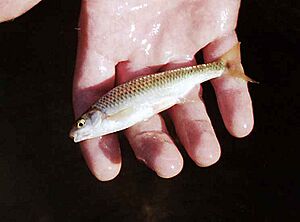Sarmarutilus rubilio facts for kids
Quick facts for kids Sarmarutilus rubilio |
|
|---|---|
 |
|
| Conservation status | |
| Scientific classification | |
| Genus: |
Sarmarutilus
|
| Species: |
rubilio
|
| Synonyms | |
|
|
The rovella (scientific name: Sarmarutilus rubilio) is a type of freshwater fish. It belongs to the Cyprinidae family, which includes carps and minnows. This fish is also known as the South European roach.
Contents
About the Rovella Fish
The rovella is a small fish. It lives in rivers and lakes. It is found mainly in parts of Italy.
Where the Rovella Lives
This fish is naturally found in the Tuscan and Latium regions of Italy. It lives in waters that flow into both the Adriatic Sea and the Tyrrhenian Sea. Sometimes, people have moved this fish to new places further south in Italy.
Why the Rovella Needs Help
The rovella is facing some challenges. It is threatened by other fish species that are not native to its habitat. These introduced species can compete for food or eat the rovella. The fish is also threatened by habitat loss. This happens when its natural home, like rivers and lakes, gets damaged or disappears.
The Rovella's Family Tree
The rovella is the only species in its group, called the genus Sarmarutilus. Scientists decided in 2014 that it was different enough to have its own group. Before that, it was part of a larger group of fish called Rutilus.
Scientists believe the ancestors of the Sarmarutilus fish came from an area called Sarmatia. This was a very long time ago, during the Middle Miocene epoch. They traveled to the Mediterranean area. Today, the rovella only lives in the Tuscany-Latium district of Italy.
What Makes the Rovella Special
The rovella is closely related to another group of fish called Leucos. There are five different species in the Leucos group.
Unlike its relatives in the Rutilus and Leucos groups, the rovella prefers to live in fast-flowing rivers. It likes moving water.
Male rovella fish have special bumps called pearl organs. These bumps are found on their heads and body scales. They become larger during the breeding season. The rovella also has different pharyngeal teeth (teeth in its throat) compared to the Rutilus fish. It is also generally smaller in size.


